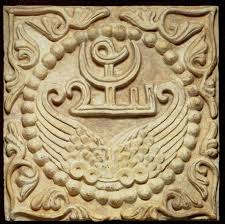The Scottish town of
Paisley became a major producer of textiles from the early 19th century and a certain pattern came to be associated with that town.
The "Paisley" design comes from the Persian "
buta" design described as being shrub shaped.
 |
| https://en.wikipedia.org/wiki/Paisley_(design) |
It became popular in Britain due to the importation of silk shawls from India during the late 18th century via the
East India Company. In the Indian subcontinent the shape is thought to be a mango.
The design is said to have become popular in India during the
Mughal era.
Like much else of Mughal culture, this emblem was Iranian in origin.
"
We find the first manifestations of this ancient motif in Scythian and Achaemenid art mainly portrayed as the wings of Homa or Senmurv and which lasted in the same manner until the Sassanian period."- Dr Cyrus Parham, in "
Nashr-e Danesh" (Iran University Press, Tehran, 1999, volume 16, number 4, page 1378)
These wings were also used on the crown of the later Sassanian monarchs from
Khosrow II to
Yazdegerd III (6th - 7th centuries). Winged animals within roundels were depicted on costly silk clothing, worn by the elites of the pre-Islamic Iranian world.
 |
| A silver Drachm of Khosrow II (from the Yazd mint dated 620AD) that I had owned. Note his crown. |
 |
| Detail of the wings on the crown. |
 |
| Sassanian era stucco with the name of "Shapur" above two wings. From: http://www.cais-soas.com/CAIS/Images2/Sasanian/artifacts/Stucco/sasanian_stucco.jpg |
 |
| https://en.wikipedia.org/wiki/Simurgh |
I wonder if such representation had to be disguised when
Islamic persecution of the Zoroastrian people began, that overt religious emblems such as the animals were abandoned but a single wing was retained, becoming more stylised over time until its meaning was no longer clear.
 |
My sketch showing a Simurgh from a Sassanian era stucco and the typical shape of the Paisley (buta) pattern.
|




